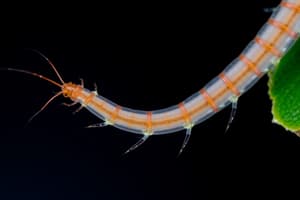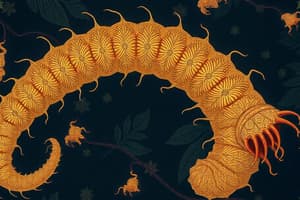Podcast
Questions and Answers
Which nematode is capable of heart-lung migration?
Which nematode is capable of heart-lung migration?
- Dracunculus medinensis (correct)
- Ancylostoma Caninum
- Trichinella spiralis
- Ancylostoma Brazillense
Which nematode is commonly referred to as 'Chinese Lantern Ova'?
Which nematode is commonly referred to as 'Chinese Lantern Ova'?
- Trichinella spiralis
- Capillaria philippinensis (correct)
- Strongyloides stercoralis
- Angiostrongylus cantonensis
Which male nematode has two pairs of conical papillae and a single testis?
Which male nematode has two pairs of conical papillae and a single testis?
- Trichinella spiralis
- Dracunculus medinensis
- Angiostrongylus cantonensis (correct)
- Ancylostoma Caninum
Which female nematode is ovoviviparous and produces larvae inside a single club-shaped uterus?
Which female nematode is ovoviviparous and produces larvae inside a single club-shaped uterus?
Which nematode parasite is the smallest of a man?
Which nematode parasite is the smallest of a man?
Which hookworm species is the most common in domestic dogs?
Which hookworm species is the most common in domestic dogs?
What is the diagnostic stage for Trichuris trichiura infection?
What is the diagnostic stage for Trichuris trichiura infection?
Which nematode is known as the 'Giant intestinal eelworm'?
Which nematode is known as the 'Giant intestinal eelworm'?
What is the infective stage for Capillaria philippinensis infection?
What is the infective stage for Capillaria philippinensis infection?
Which nematode is responsible for Trichuriasis?
Which nematode is responsible for Trichuriasis?
What is the mode of transmission for New World hookworm infection?
What is the mode of transmission for New World hookworm infection?
Which nematode produces peripheral nodules in the lungs called 'coin lesions'?
Which nematode produces peripheral nodules in the lungs called 'coin lesions'?
What is the common name for Ancylostoma caninum?
What is the common name for Ancylostoma caninum?
'Threadworm' is a common name for which parasite?
'Threadworm' is a common name for which parasite?
'Dracunculus medinensis' causes which condition when accidentally ingested?
'Dracunculus medinensis' causes which condition when accidentally ingested?
What is the smallest intestinal nematode mentioned in the text?
What is the smallest intestinal nematode mentioned in the text?
Flashcards
Hookworm infective stage
Hookworm infective stage
The stage of a parasitic hookworm that is able to infect a new host.
Ascaris Lumbricoides
Ascaris Lumbricoides
A large intestinal nematode, a roundworm, causing ascariasis.
Diagnostic Stage of Necator Americanus
Diagnostic Stage of Necator Americanus
The stage of Necator Americanus used to diagnose an infection.
Trichuris Trichiura Infection Stage
Trichuris Trichiura Infection Stage
Signup and view all the flashcards
Zoonotic infection
Zoonotic infection
Signup and view all the flashcards
Strongyloides Stercoralis
Strongyloides Stercoralis
Signup and view all the flashcards
Dracunculus Medinensis
Dracunculus Medinensis
Signup and view all the flashcards
Trichinella Spiralis transmission
Trichinella Spiralis transmission
Signup and view all the flashcards
Ascaris Lumbricoides ovum
Ascaris Lumbricoides ovum
Signup and view all the flashcards
Hookworm ova
Hookworm ova
Signup and view all the flashcards
Strongyloides Stercoralis larva
Strongyloides Stercoralis larva
Signup and view all the flashcards
Hookworms & Anemia
Hookworms & Anemia
Signup and view all the flashcards
Necator Americanus diagnostic stage
Necator Americanus diagnostic stage
Signup and view all the flashcards
Rhabditiform larva
Rhabditiform larva
Signup and view all the flashcards
Filariform larva
Filariform larva
Signup and view all the flashcards
Study Notes
Intestinal Nematodes
- Larval stages of hookworms and Strongyloides: considered as feeding stage, larvae with an open mouth, shorter and robust than filariform larva, not infective.
- Filariform larva: esophagus is uniform throughout, considered as the non-feeding stage, larvae with a closed mouth, longer and slender than rhabditiform larva, infective stage.
Intestinal Parasites
- Ascaris Lumbricoides (roundworms): largest intestinal nematode, common name: giant intestinal roundworm, disease: ascariasis, habitat: intestinal tract, infective stage: ingestion of embryonated ova (fertilized or unfertilized eggs).
- Ancylostoma Duodenale & Necator Americanus (hookworms): disease: hookworm infection, habitat: large intestine, infective stage: ingestion of embryonated ova.
- Trichuris Trichiura (whipworms): disease: trichuriasis, habitat: large intestine, infective stage: ingestion of embryonated ova.
Diagnostic Stage
- Necator Americanus: diagnostic stage: filariform larva, mode of transmission: skin penetration.
- Trichuris Trichiura: diagnostic stage: adult worm, mode of transmission: ingestion of embryonated ova.
- Capillaria Philippinensis: diagnostic stage: adult worm, mode of transmission: ingestion of raw or undercooked fish.
Zoonotic/Non-Human Infection
- Ascaris of dogs: can infect humans, called ascaris.
- Toxocara Canis: can infect humans, disease: visceral larva migrans, transmission: accidental ingestion of embryonated eggs.
- Ancylostoma Caninum: can infect humans, disease: cutaneous larva migrans, transmission: skin penetration.
- Dirofilaria Immitis: can infect humans, disease: produce peripheral nodules in the lungs, transmission: mosquito bite.
Extra-Intestinal Mode of Transmission
- Trichinella Spiralis: transmission: consumption of raw or undercooked meat, especially pork.
- Dracunculus Medinensis: transmission: ingestion of contaminated water.
Ascaris Lumbricoides
- Largest intestinal worm: soil-transmitted helminth, ova: regularly ovoid, with thick shell, cytoplasm contains organized germ cells.
- Adult: lives primarily in jejunum, female: contains egg in its body, body is divided into two parts: anterior and posterior, two types: typical and atypical female.
- Male: has caudal alae, single spicule and unspined sheath, slender than female, stichosome: esophageal structure with rows of secretory cells.
Hookworms
- Necator Americanus, Ancylostoma Duodenale, Ancylostoma Caninum, Ancylostoma Braziliense: blood-sucking nematodes causing anemia, attached to intestinal mucosa, soil-transmitted helminths, capable of heart-lung migration.
- Ova: all hookworm eggs are alike, ovoid, with thin hyaline transparent shell, contains 2-8 germ cells.
- Adult: has a mouth/buccal cavity with dental pattern, Necator americanus: with semilunar cutting plates, Ancylostoma duodenale: with 2 pairs of teeth, Ancylostoma caninum: with 3 pairs of teeth, Ancylostoma braziliense: with 1 pair of teeth.
- Copulatory bursa: structure found among male nematode used for copulation, parts: copulatory spicules and dorsal rays.
Strongyloides Stercoralis
- Smallest nematode of a man: capable of heart-lung migration, mode of living: facultative (free-living/parasitic), parthogenic: can produce eggs even without male.
- Ova: similar to those of hookworms, eggs smaller than those of hookworms, contains larva, referred to as “Chinese Lantern Ova”.
- Larval stages: L1: Rhabditiform (feeding stage), L3: Filariform (infective stage).
Dracunculus Medinensis
- Named by Galen: not a true filaria, larva: have a well-developed digestive tract, never found in blood or tissues of the host, discharged directly into the water.
- Female: ovoviviparous parasite, blister to form, male: inconspicuous.
Trichinella Spiralis
- Parasite of carnivorous mammals: common in rats and in swine fed uncooked garbage, may occur in humans who consume uncooked pork.
- Larva: encysted larva is the diagnostic and infective stage, fully developed, coiled in a spiral and gradually become surrounded by a sheath drive from muscle fibers.
- Adult female: larger, straight, pointed tail, viviparous, single club-shaped uterus containing larva, single ovary.
- Male: curved posteriorly, possesses two pairs of conical papillae, single testis, cloaca found at the caudal end, absent spicule.
Angiostrongylus Cantonensis
- Other name: parastrongylus cantonensis: final/definitive host: Rattus Norvegicus, Rattus Rattus, accidental host: humans, intermediate host: mollusk/snail, paratenic host: prawn, crab, vegetation.
- Infective stage: L3 larva to rats, L1 larva to slugs and land snails.
- Adult: equipped with a uterus with barber’s pole appearance.
Studying That Suits You
Use AI to generate personalized quizzes and flashcards to suit your learning preferences.




